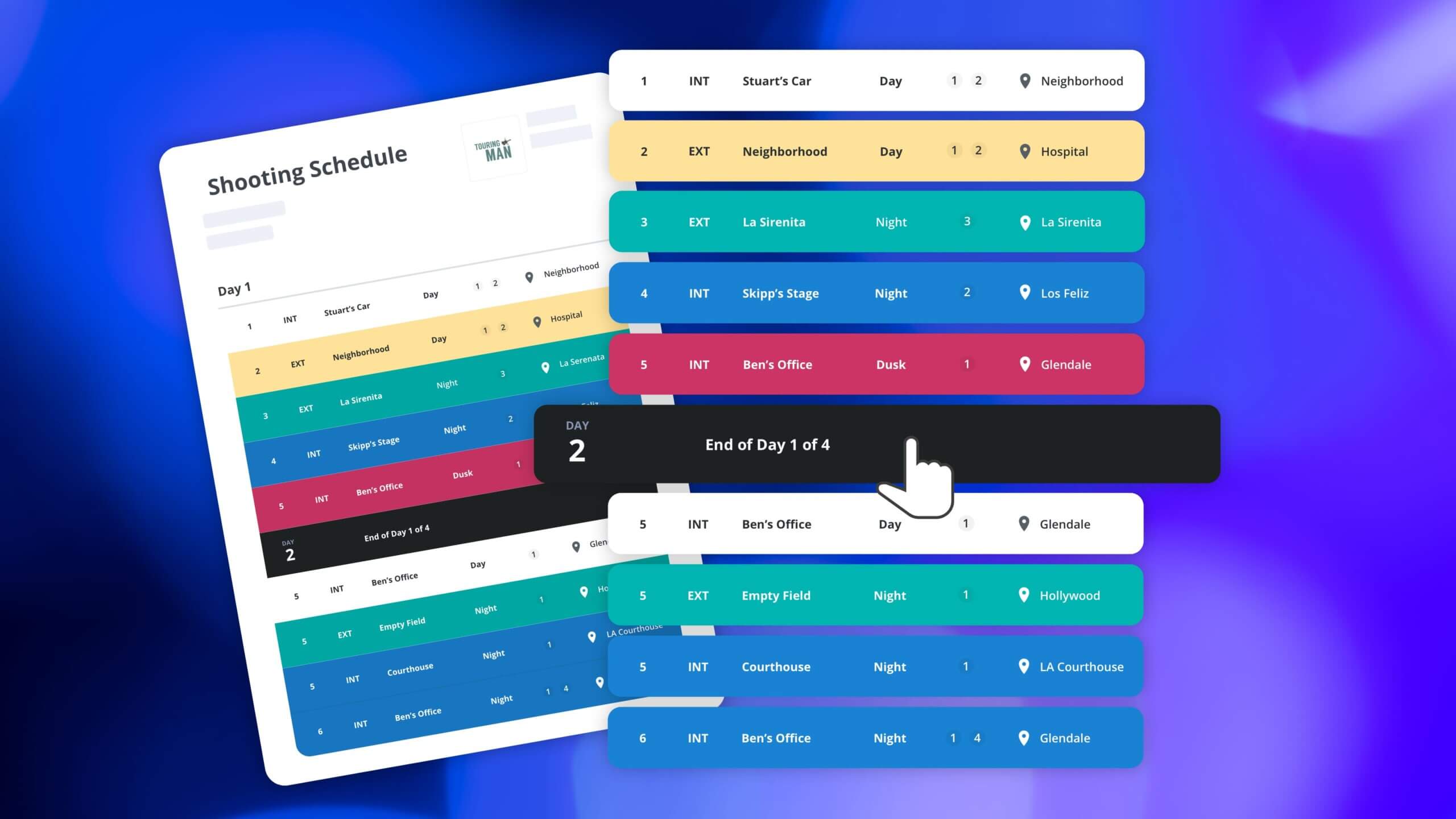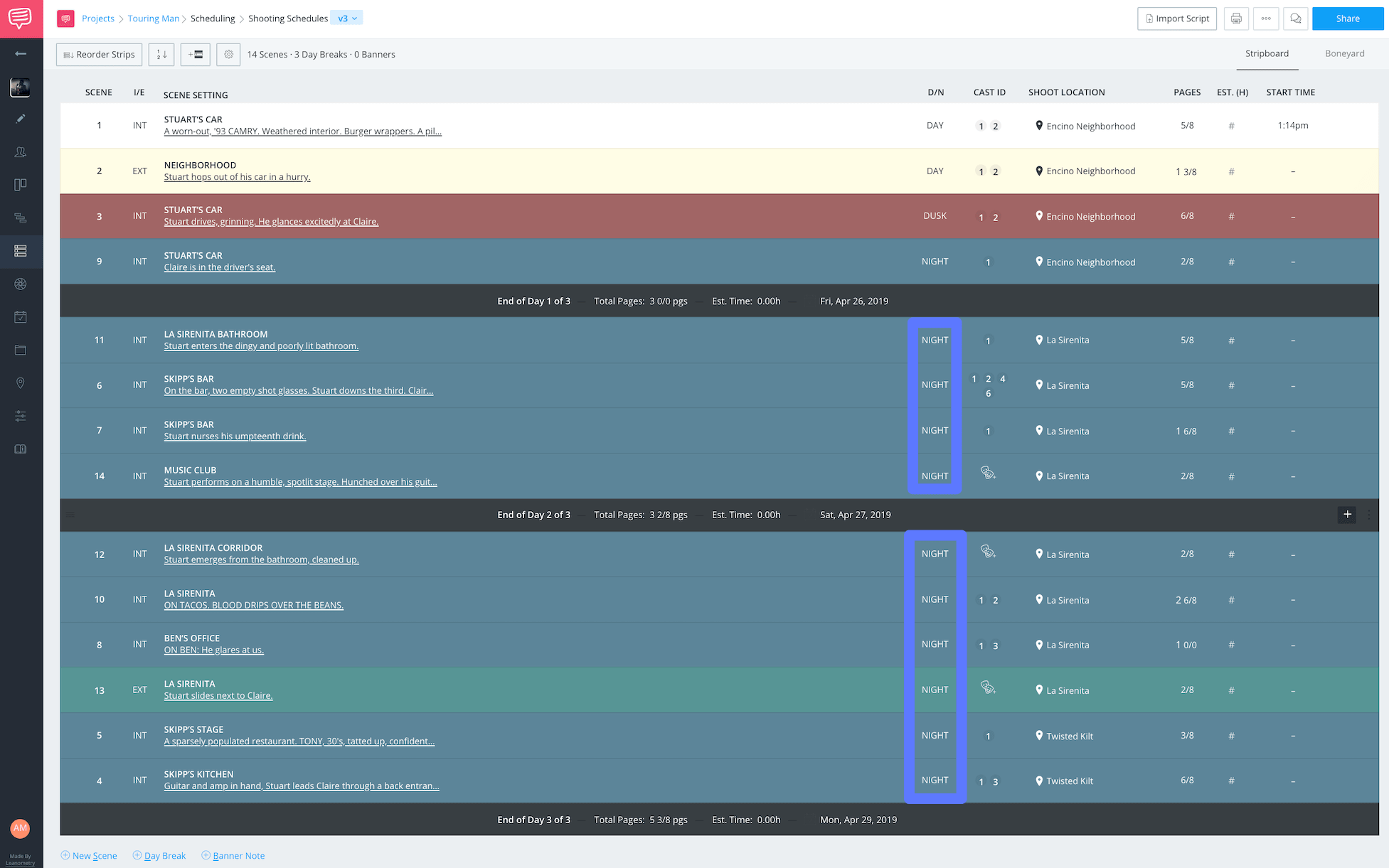There are no hard and fast rules when it comes to scheduling your film shoot. In fact, every producer has their own tried and true method to scheduling their shoot. But for as many scenes that you create, there is an equal number of possibilities when it comes to arranging them.
There are many ways to schedule your shoot, this post discusses what’s most important to consider, and why. It goes through the hierarchy of considerations to have the most sensible and cost effective production. Let’s jump in.
Brief Overview
Careful considerations
We know that there is a hierarchy on set, but the most important hierarchy is the one you follow when scheduling.
What should you consider first? Why?
Let’s use the short film, Touring Man, as an example.
But before we determine how to arrange the strips, let’s see what we need for each scene in the film. We’ll find these elements in the script breakdown.
Script Breakdowns
1. Know what you're shooting
First you need to know what you’re working with at the most fundamental level. Each scene needs to be broken down.
Step One:
It’s easiest if our script is digitized and brought into our software.
Let’s use StudioBinder Script Breakdown Software and run a breakdown of this scene from Touring Man:
In this scene, we are in the main character's car. We have identified where he is, (his car), who he is, (Stuart), other props like his guitar, pillow, and a blanket. We've also tagged a set dressing, the "smudge" on the window.
Location, character, and other elements within a scene will affect our budget and therefore must be known at the onset.
For example, knowing what kind of car we will need will determine our car rental price, informing our budget.
Any element you might need for the scene, especially where it's going to be, is of utmost importance when scheduling.
Related Posts
Location on the Stripboard
2. Know where you're shooting
You find out where you'll be shooting as you break down the script. It's information that comes directly from the break down which is why script breakdowns are number one.
But once you have your elements, scheduling by location is vital.
Because you broke down the scene...
Step Two:
... if you simply generate the shooting schedule in the same software, all of your elements tagged will populate in the strips:
You can assign locations here and drag and drop each strip to schedule your shoot days by these locations.
You really do just want to start by simply reading each strip for what it is, an attenuated version of your script, laid bare. Assign your locations or you can also reorder the strips based on “scene setting.”
The scene setting is always an important consideration in that it could be the difference in travel cost and time or crew availability.
DID YOU KNOW?
Production board strips are colored according to whether they are Interior or Exterior and Day or Night. Different production management software has slightly varying color palettes, the standard universal palette will be recognized by those who use software and those who don’t.
So how else can we arrange our Touring Man shooting schedule? The film has 3 main locations, covering more than two pages, so we can organize them accordingly.
We shift the two main locations to the last two days by page count and we move the two dangling day scenes to the top of the shoot:
Grouping your locations by scene setting informs which of these locations is the most essential, how long you will be there, and how much of your budget could be going to set dressings or location rental.
Related Posts
Time of Day Matters
3. Know when you're shooting
Determining the time of day for each scene is also a necessary step. The time of day required could affect location availability, location costs, and even security.
It could also affect your budget in other ways if other techniques are used. For example, using the "day for night" technique. Often this technique can help you save a few bucks.
DAY-FOR-NIGHT DEFINITION
WHAT IS DAY FOR NIGHT?
Day For Night is any number of filmmaking techniques that are used to replicate the appearance of a night time scene while being filmed in daylight. Day for night is usually done when light availability or budgeting is a concern. And occasionally for creative purposes.
The effect of day for night can be done using film stock, or digital image sensors, due to their lack of sensitivity in low light situations.
Most of Touring Man occurs at night or inside at night, so we did use day for night for some scenes.
While we did arrange our schedule by location, there weren't many locations in this film. So it was easiest to arrange the scenes by time of day. See below:
Scheduling short films is great practice for when it comes time to schedule your feature or episode. Once your breakdown is done, keep location and time of day at the forefront of your mind. When you know what you need ahead of time, it makes it much easier to know where you can cut corners later.
Knowing where you can be flexible will especially necessary for the next step.
Related Posts
Last But Not at All Least
4. The wildcard..talent at the top
Talent is potentially the most important factor when scheduling.
Why didn’t I put it at the top of the list?
It’s not at the top because you need to know which actor is in which scene via step one, the script breakdown. You will also have to know where you need talent to be, before you ask them to be somewhere (step two, location). And of course, what time of day you need them to be there, or step three.
But that being said, the talent comes first because your entire schedule could change based on their contracts, state regulations, or even demands.
Disrespecting their prior commitments or contractual agreements could not only hurt your reputation for future work, but your current production.
If your leading lady is contracted for eight hour days, or must finish at a certain time or on a certain date, the producers and 1st assistant directors must move them a little higher up in the pecking order.


It's unlikely you'll have this problem on a short
Flexibility is important especially when working with top names.
When arranging your strips, give yourself some room for hiccups or changes. It may not be smooth sailing from start to finish, but if you take these steps, or at least keep them in mind, you'll be in a good position when obstacles come up.
Now that you have a handle on how to arrange strips on a stripboard, challenge yourself with scheduling something a bit more involved.
Related Posts
UP NEXT
How to Schedule a Montage
A brief mention in this article is not enough to understand the importance of the correct formatting and scheduling of a montage. A montage can add days to your schedule and zeros to your bottom line.
Learn how to effectively schedule a montage so that you aren’t surprised when your time and money are moving quickly over a few scenes you didn’t even know you had.







thanks for the information